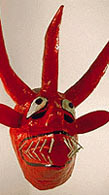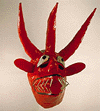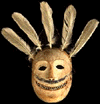 |
||
  |
||
|
|
What Masks RevealIntroductionIn this lesson, students explore the cultural significance of masks by investigating the role they play in ceremonies and on special occasions in societies from widely separated regions of the world. They then reflect on masking behavior in American society, such as at Halloween and in the circus. Learning Objectives(1) To become aware of the social purpose and significance of cultural artifacts such as masks. (2) To recognize the influence that stereotyping can have on one's response to artifacts of a different culture or society. (3) To explore connections between cultures and societies -- including American society -- relating to their use of masks.Guiding Question:What can masks tell us about the people who make them?Background
In general, masks have two important social functions: (1) they provide a disguise for the wearer and (2) they allow the wearer to assume the identity, at least temporarily, of some other person or being. An individual in clown makeup, for example, is allowed in most societies to behave in ways that would otherwise be deemed inappropriate or offensive. This is certainly entertaining to the viewers, but it also highlights and presumably conveys something about the boundaries of what is appropriate in that particular society. Traditionally, masks are often worn at dangerous times of "border-crossing" -- what anthropologists call periods of "liminality" -- such as funerals or the planting and nurturing of spring crops. Not unexpectedly, these are also times when the spirits are in closest contact with the people. In religious rituals during these times, the person wearing the mask often becomes the spirit being represented, or at least serves as a medium through which the spirit is allowed to communicate with the people, as in many American Indian and African societies. Of course, masks can also serve as simple enhancements to story-telling, as a way for actors to "disappear" into the roles they are playing (Japanese Noh masks, for example). Yet even this use of masks can be more complicated than one might suppose: at one time, for instance, Korean masked dance troupes ritually burned their masks after they had been used, suggesting that an element of religious tradition had carried over to the stage. 1
Divide the class into small groups. Provide each group with pictures of masks
from three cultures, but do not tell students where they are from. All groups
can work on the same three masks, or you can vary the assortment. Select examples
from these EDSITEment websites:
2 Have the groups produce a brief catalog description for each mask, including a description of its appearance and hypotheses about its use and where it comes from. Students can imagine themselves museum curators or appraisers like those on the popular public television program, Antiques Road Show. 3 How can you tell the difference between a smiling mask and one that is snarling or threatening to bite? Can the meaning of facial expressions differ from culture to culture? 4 Conclude this discussion by having students suggest questions they would ask in order to understand the cultural significance of a mask. List their suggestions on the chalkboard. Among the questions that might appear on their list:
5 Provide each group with background information on their masks (available at the websites listed above) and maps they can use to locate the regions where their masks were created. You can print out outline maps of the Caribbean, the Arctic, and Africa in the "Atlas" section of the National Geographic Xpeditions website on EDSITEment. 6 Have students pair-off in their groups to revise their catalog descriptions, giving each pair one mask to work on. Direct students to use the background information to answer the questions they listed as important for understanding the mask's cultural significance. Have them locate where the mask comes from on the appropriate map and organize the other information in a chart or with bullet-points. Advise students that they might not find answers to all their questions. 7 When they have completed their research, have students share information in a "show and tell" class discussion. Display the masks in different groupings to highlight similarities and differences. Some suggestions:
8 Conclude the lesson by talking about the use of masks in American society. Students might mention Halloween, Mardi Gras, masquerades, theatrical performances, the circus, or clowns and mimes in mask-like makeup. How do these uses of masks compare to their use in traditional societies?
Collaborative
or Take-Home Activity Extending the Lesson
Standards Alignment View your state’s standards |
||||||||||||||||||||||||||||||||||||||||||||||||||||||||||||||
  |
||
| EDSITEment contains a variety of links to other websites and references to resources available through government, nonprofit, and commercial entities. These links and references are provided solely for informational purposes and the convenience of the user. Their inclusion does not constitute an endorsement. For more information, please click the Disclaimer icon. | ||
| Disclaimer | Conditions of Use | Privacy Policy Search
| Site
Map | Contact
Us | ||



